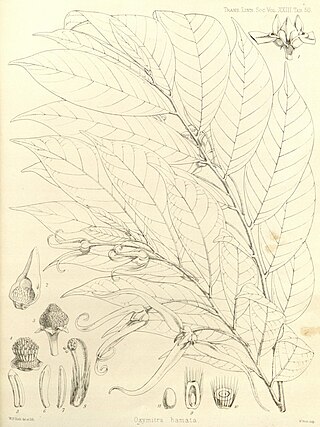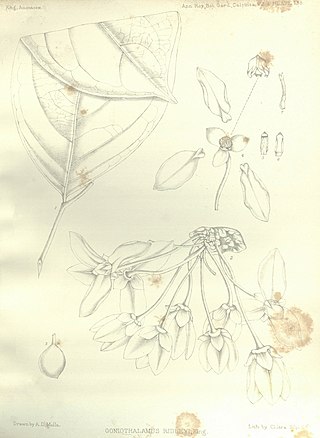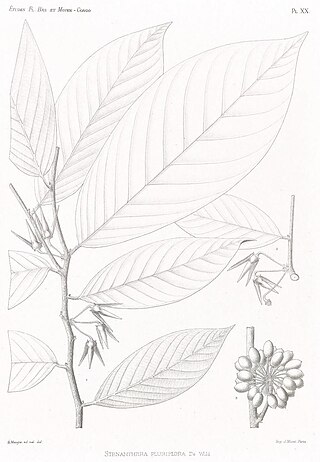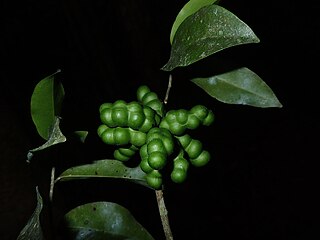
Quercus georgiana, the Georgia oak or Stone Mountain oak, is a rare deciduous red oak, native to the southeastern United States.

Quercus phellos, the willow oak, is a North American species of a deciduous tree in the red oak group of oaks. It is native to the south-central and eastern United States.

Neostenanthera hamata is a species of plant in the family Annonaceae. It is found in Ivory Coast, Ghana, Liberia, and Sierra Leone. George Bentham, the English botanist who first formally described the species, using the basionym Oxymitra hamata, did not explicitly explain the specific epithet, but it has distinctive outer petals with hooked tips.

Quercus hemisphaerica is a species of oak native to the southeastern and south-central United States. It is in the red oak section of Quercus sect. Lobatae. It is often confused with and closely related to Quercus laurifolia, from which it differs in several key characteristics.
Quercus langbianensis is an uncommon oak tree species in the family Fagaceae. It is placed in subgenus Cerris, section Cyclobalanopsis, the ring-cupped oaks. These differ from other Quercus groups in that they have acorns with distinctive cups: usually with substantial rings, made-up of scales that have grown together. This species can be found in sub-tropical and tropical seasonal forests of Cambodia, China and Vietnam.
Goniothalamus nitidus is a species of plant in the family Annonaceae. It is native to Borneo. Elmer Drew Merrill, the American botanist who first formally described the species, named it after its shining leaves.

Goniothalamus ridleyi is a species of plant in the family Annonaceae. It is native to Borneo, Peninsular Malaysia, Sumatra and Thailand. George King, who first formally described the species, named it after the English botanist Henry Nicholas Ridley who collected the specimen King examined.
Goniothalamus rongklanus is a species of plant in the family Annonaceae. It is native to Thailand. Richard Saunders and Piya Chalermglin first formally described the species and named it after Phu Hin Rong Kla National Park in Thailand.

Hexalobus crispiflorus is a species of plant in the family Annonaceae. It is native to Angola, Benin, Cameroon, Central African Republic, Congo, DR Congo, Gabon, Ghana, Guinea, Guinea-Bissau, Ivory Coast, Liberia, Nigeria, Senegal, Sierra Leone, Sudan, Togo and Zaire. Achille Richard, the French botanist who first formally described the species, named it after its wavy petals of its flowers.

Hexalobus monopetalus is a species of plant in the family Annonaceae with the common name baboon's breakfast. It is native to Angola, Benin, Botswana, Burkina Faso, Cameroon, Central African Republic, Chad, Gambia, Ghana, Guinea, Guinea-Bissau, Ivory Coast, Liberia, Malawi, Mali, Mozambique, Namibia, Niger, Nigeria, Senegal, South Africa, Sudan, Tanzania, Togo, Uganda, Zambia, Zaire and Zimbabwe. Achille Richard, the French botanist who first formally described the species, using the basionym Uvaria monopetala, named it after its petals which are fused at their base.
Monodora crispata is a species of plant in the family Annonaceae. It is native to Cameroon, Equatorial Guinea, Gabon, Ghana, Guinea, Ivory Coast, Liberia, Nigeria, and Sierra Leone. Heinrich Gustav Adolf Engler, the German botanist who first formally described the species, named it after its curled petal margins.

Monodora tenuifolia is a species of plant in the family Annonaceae. It is native to equatorial Africa. George Bentham, the English botanist who first formally described the species, named it after its slender leaves.

Mischogyne elliotiana is a species of plant in the Annonaceae family. It is native to Cameroon, Gabon, Ghana, Guinea-Bissau, Ivory Coast, Liberia, Nigeria, Sierra Leone, and Zaire. Adolf Engler and Ludwig Diels, the German botanists who first formally described the species using the basionym Uvaria elliotiana, named it after George Scott-Elliot the botanist who collected the specimen they examined.

Monodora angolensis is a species of plant in the family Annonaceae. It is native to Angola, Cameroon, Central African Republic, Democratic Republic of the Congo, Equatorial Guinea, Gabon, Ivory Coast, Nigeria, Republic of the Congo, Sudan, Tanzania, Uganda, Zambia and Zaire. Friedrich Welwitsch, the Austrian botanist who first formally described the species, named it after Angola where he found it growing near the town of Pungo-Andongo.

Neostenanthera myristicifolia is a species of plant in the family Annonaceae. It is native to Benin, Cameroon, The Central African Republic, The Democratic Republic of the Congo, Equatorial Guinea, Gabon, Nigeria, and The Republic of the Congo.

Uvariastrum hexaloboides is a species of plant in the Annonaceae family. It is native to Tanzania, Zambia and Zaire. Robert Elias Fries, the botanist who first formally described the species using the basionym Uvaria hexaloboides, named it after a different species Hexalobus monopetalus which he thought its flowers and vegetative parts resembled.

Uvariastrum insculptum is a species of plant in the Annonaceae. It is native to Cameroon, Gabon, Ghana, Ivory Coast, Liberia, Nigeria, and the Republic of the Congo. Adolf Engler and Ludwig Diels, the botanists who first formally described the species using the basionym Uvaria insculpta, named it after the secondary veins on its leaves which are distinctly sunken.

Uvariastrum pierreanum is a species of plant in the Annonaceae family. It is native to Cameroon, the Central African Republic, the Democratic Republic of the Congo, Equatorial Guinea, Gabon, Ghana, Guinea, the Ivory Coast, Liberia, Nigeria, Sierra Leone and the Republic of the Congo. Adolf Engler, the botanist who first formally described the species, named it after the French botanist Jean Baptiste Louis Pierre.

Uvariopsis congensis is a species of plant in the Annonaceae family. It is native to Angola, Cameroon, the Central African Republic, the Democratic Republic of the Congo, Gabon, Ivory Coast, Kenya, Sudan, Uganda, Zambia. Walter Robyns and Jean Ghesquière, the botanists who first formally described the species, named it after the Belgian Congo, now called the Democratic Republic of the Congo, where the specimen they examined was collected in the town of Kisantu near the Inkisi River.
Quercus rekonis is a species of oak in the subgenus Quercus indigenous to Mexico. It was described in 1924 by William Trelease. It is most commonly found in the Mexican state of Oaxaca, but can be found throughout much of western Mexico. Quercus rekonis grows in a subtropical biome.















